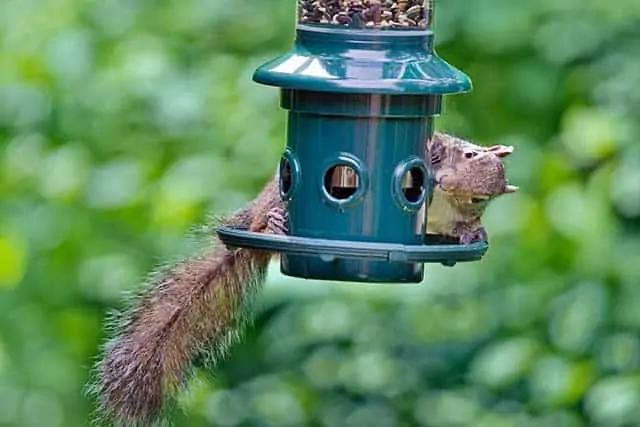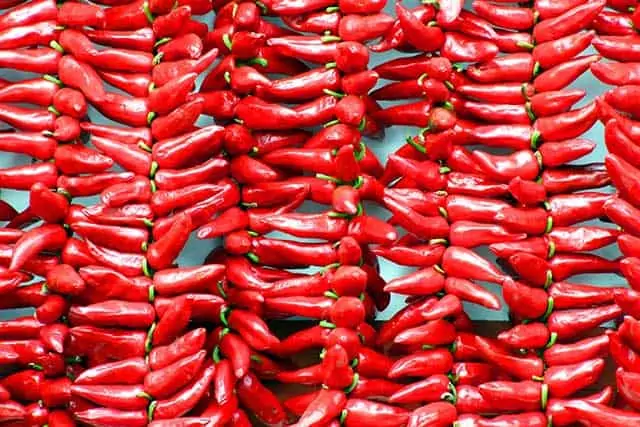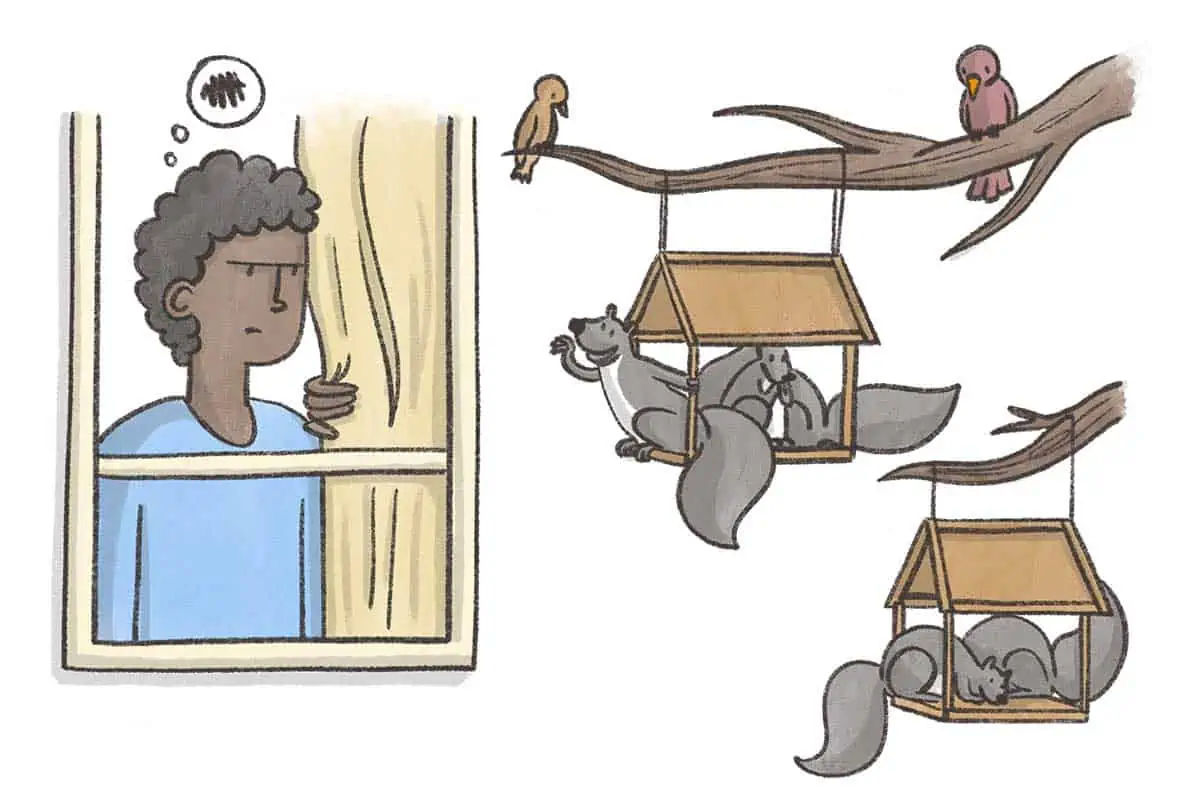One fundamental truth is that everyone who has ever enjoyed feeding birds in their garden knows. Squirrels are constantly trying to steal your seed in birdfeeders. You’ll need to learn how to keep squirrels out of your bird feeders if they’re a threat in your yard.
With their capacity to jump great distances, climb all surfaces, balance on the tiniest footholds, squeeze through tiny apertures, and chew their way through plastic and metal, they may appear unstoppable. Nonetheless, you may ensure that your seed is used only for your feathered pals by a little planning and a few tricks.
HOW TO KEEP SQUIRRELS OUT OF BIRD FEEDERS – TRY THESE 5 THINGS
We’ll look at five methods for keeping squirrels out of bird feeders in this article.
1. CHOOSE A “SQUIRREL PROOF” BIRD FEEDER

Squirrel defense is incorporated into many bird feeders. A weight activated closing mechanism or a cage mechanism are the two most common strategies for squirrel control in squirrel proof feeders.
WEIGHT ACTIVATED CLOSING SYSTEMS
The squirrels’ weight is used to activate a closing mechanism that blocks the food ports in these kinds of feeders. The squirrel will be unable to get to the seed when the door comes down over the ports. The biggest backyard birds weigh just a maximum of 160 grams, whereas grey squirrels weigh about 400 to 800 grams. The majority of the songbirds you’ll be feeding weigh less than 100 grams, if they’re lucky. It’s much lighter than a squirrel! These weighted systems are typically very effective. The closing mechanism will not be triggered if multiple birds sit on a weighted perch at the same time.
A weight activated system is used in three popular styles of feeder. Feeders include tube feeders, hopper feeders, and fling feeders.
- The Squirrel Buster Plus is my favorite tube feeder. The squirrels have never beaten this feeder, which I’ve had for many years. They can’t hang upside down and reach the ports because it’s too long. It also has a large supply of seed, reducing the need for frequent visits in the winter! It also comes with a ring perch, which larger birds seem to prefer. Brome’s squirrel buster series of feeders are excellent, and our review article here can help you choose the appropriate one for you.
- The hopper style feeder seems to be liked by all kinds of birds. The Woodlink Ultimate Squirrel Feeder is ideal.
- A squirrel’s weight is used to activate a motor that turns the perch around, “flipping” it off the feeder, in Flipper feeders. The Yankee Flipper is the most well-known and adored.
CAGE SYSTEMS
Many squirrels are much larger than songbirds, thus cage systems work on the simple principle of quantity. The squirrels will be unable to enter through the cages if you place the seed inside them with tiny openings.
Tube-style feeders with a massive metal cage that encircles the feeder are the most common. These feeders, in addition to excluding larger birds like Starlings and Grackles, can also exclude other species. The feeders may be monopolized by these birds, pushing out smaller birds. Large birds such as Cardinals and Blue Jays, on the other hand, will be unable to enter the cage because of this. The Droll Yankees Feeding Cages are squirrel-proof.
If you’re on the fence about what to buy, here’s an article we wrote on some of the best squirrel proof bird feeders you can get.
2. USE A BAFFLE

A squirrel barrier is intended to be a baffle placed over or under a bird feeder. Dome, saucer, and torpedo-shaped baffles are all possible.
- Dome-shaped baffles, which resemble an umbrella, are placed above a bird feeder. Rather than being pole mounted, these are often used for feeders hanging from trees. The theory is that since squirrels will be unable to maintain solid footing while attempting to sneak past the dome and get the food, they’ll slip. The more effective the dome will be, the bigger it is. These baffles offer some protection to the feeder below, in addition to being an added benefit. Birds Choice Dome is an app for your iPhone.
- These baffles, which fit over your bird feeder pole beneath the bird feeders, are shaped like big metal plates or upside down cones. On wood or metal poles, squirrels are good climbers. Squirrels are unable to pass through these baffles, which serve as a barrier. The bigger the better, once more. Because they will try, you want a large space that the squirrel will be unable to stretch and explore. The Woodlink Audubon Squirrel Baffle
- These baffles are shaped like torpedoes and are meant to fit onto your bird feeder pole. Squirrels cannot gain balance and stability because of their slick surface and spring-loaded bounce. Audubon’s Torpedo Squirrel Baffle
Note: So that the squirrels can’t jump over it from the ground, pole-mounted baffles (such as the saucer or torpedo) must be positioned high enough up the pole. When placing your baffle, keep this in mind: they can jump approximately 5 feet vertically.
3. USING AN OPTIMUM LOCATION

Location, location, location is true with any real estate! When it comes to buying birdfeeders, one of the most effective ways to keep squirrels at bay is to pick a spot that isn’t particularly squirrel-friendly. Hanging your feeder from a tree limb or a deck pole is asking for trouble. Try mounting your feeder as far away from squirrel-accessible surfaces (tree limb, shrubs, deck railing, shed, or garage roof) as possible.
Squirrels have a great ability to jump. They may travel a long way, whether they’re starting from a standstill or leaping into the air. They can leap up to 10 feet between objects from the ground straight up and jump around 5 feet high.
Place the pole at least 10 feet away from any surface a squirrel can jump from and at least five feet off the ground when using a pole setup.
Using the suspension technique is a good way to hang your feeder from trees. Find two trees that are at least 10 feet apart and are fairly big. Hang your feeder from the dead center of a wire that runs between the trees, pulled taught. Squirrels should have a difficult time getting a solid grip if you use a thin, sleek wire/cord like monofilament fishing line or galvanized wire rope. Nonetheless, as an added measure of security, you might want to install a few “spinners” on each side of the feeder. Plastic soda bottles or PVC pipe might be used as spinners if they roll on a wire and fling a squirrel away.
Lastly, your window! Is there any way you can use it? In recent years, feeders that use suction cups to adhere to your windows have grown in popularity, and there are a variety of options available. This may be a excellent option for keeping seed out of the sight of interfering squirrels if you have windows on your home that are not near deck railings or garage roofs. Small gardens, flats, or condominium complexes may also benefit from it. A fantastic and popular design is Nature’s Hangout Window Feeder. Our other informative articles on how to utilize window feeders, as well as our choices for some of the best window feeder models, are worth a read if you’re interested in window feeders.
4. USE FOOD SQUIRRELS DON’T LIKE

It’s time to spice things up! The squirrels can’t handle the heat, so you might be someone who constantly says “pass the hot sauce.”
The chemical capsaicin is what makes chili peppers so hot. The substance has a strong irritant effect when it comes into contact with certain receptors, and the brain feels pain as a result. When exposed to harmful heat, these symptoms are extremely similar. As a result, chilies have the reputation of being “hot.” This response to capsaicin is seen in the majority of animals, including squirrels. Birds, on the other hand, do not. These animals can eat the hottest of the hot chilies and not feel any discomfort since their receptors are very insensitive to capsaicin, a chili chemical.
Because the birds may devour the seeds and then disseminate them in their droppings, this is a significant ecological advantage for chili peppers. At our bird feeders, it’s also a natural loophole to take advantage of.
Several firms have started producing suet and birdseed with hot pepper as a result of this finding. You may naturally make your food unattractive to squirrels by purchasing suet or birdseed loaded with chili pepper oils and seasoning. The majority of them can detect the spice and will not even try to eat it. Others will be out for a drink as soon as they taste it.
Squirrels despise it, but birds adore it, as I am intimately aware. I’ve offered some as a present, and the birds seem to like it much more than their usual suet, according to those who have received it!
You may also purchase “hot sauce” or pre-spiced seed like Coles Hot Meats Seed to put on your own custom seed blend.
You might also try mixing a quarter cup of hot pepper with each 10 pounds of seed and see how it tastes. Sprinkle cayenne pepper or a similar pepper spice into your birdseed blend. Just keep in mind that if you get hot pepper in your palms, you’ll most likely transfer it to your eyes if you touch your eyes. When working with hot pepper or items containing hot pepper, always wear disposable gloves. Also, don’t inhale it or blow it into your eyes.
Squirrels also show a preference for Nyjer (thistle) seed, millet, and safflower seed, but not as much. Using just these seeds in your feeder might make your feast unpalatable to squirrels. The Nyjer seed, on the other hand, is the only seed I’ve noticed squirrels consistently neglect even in the dead of winter, when they are at their most greedy. Although some of your other favorite backyard birds, such as cardinals or woodpeckers, are unlikely to be interested in Nyjer, he is a favorite of all types of finches.
5. DIVERT ATTENTION BY FEEDING YOUR SQUIRRELS

Your best defense might be diversion if you can’t drive the squirrels away from a particular feeder. Squirrels will certainly do amazing acrobatic acts in order to obtain what they want. They, like most creatures, prefer to conserve energy rather than expending it unless they have no other option. As a result, they will not go to the effort to climb into your bird feeders if you leave an easy accessible food source out for them.
Seed or suet balls can be hung from tree branches. You should remove piles of in-shell peanuts, walnuts, or even acorns that you’ve gathered.
Squirrels are a fascinating species that can be viewed. Many people opt for squirrel feeders that will keep the squirrels occupied in one location in order to keep an eye on their amusing antics.
- Jar Feeder: A jar feeder should be able to accommodate any variety of nuts, seeds, or treats you want to leave for the squirrels. Uncle Dunkl’s Squirrel Jar Feeder
- Dry corn cobs are also a favorite of squirrels, and they’re frequently offered as snacks. A basic platform with a post that you screw the cob onto is often used for corn feeders. Picnic Feeder for Wildlife Woodcrafts
METHODS TO AVOID
There are many squirrel deterring methods I’ve seen on the internet that simply are not safe for the squirrels or the birds. If you’re an avid bird watcher chances are you’re also a nature lover. In the spirit of appreciating all mothers natures diverse creatures, please avoid using these potentially harmful methods when trying to keep squirrels out of bird feeders;
- The metal slinky– some people claim that wrapping a metal slink around the bottom of a pole will make it difficult for squirrels to climb. This may seem to be a good idea at first, but they’ll eventually figure out a way to get past it. Birds, chipmunks, and squirrels, on the other hand, can be caught and trapped in metal wiring.
- Another tip I’ve seen several people debate is greasing the pole using different oils, greases, or vaseline. This is a task that requires constant reapplication because it gets messy. Grease and Vaseline might become stiff in very cold temperatures if you reside in a particularly frigid environment. This makes climbing the pole even simpler for the squirrels. Birds may gain the oils and greases on their feathers by accident, which may limit their abilities to fly if it’s too sticky for them to clean off easily.
- This is, quite simply, inhumane. Poisoning In addition, it is very harmful to other animals via secondary poisoning. Accidentally poisoning your own animals or neighborhood dogs and cats would be extremely easy, and they might consume a poisoned squirrel. The owls and hawks that devour squirrels are another example of creatures that may be killed or severely injured by poisonous food.
CONCLUSION
The moment you turn your back, squirrels get a lot of hate for devouring all of your expensive birdseed. Like a group of ravenous teenagers raiding your kitchen, they’re like a pack. You should, however, be able to coexist peacefully with your furry backyard neighbors by following the strategies outlined above. Squirrels are bright, nimble, highly entertaining to observe, and oh so adorably squirrelish. Even if you don’t want to give your birdfeeders up, share your yard with them.
